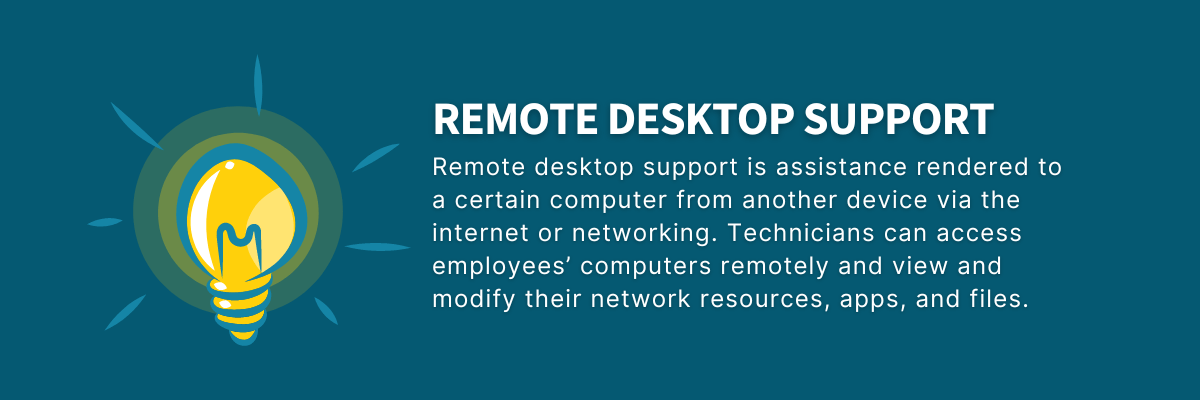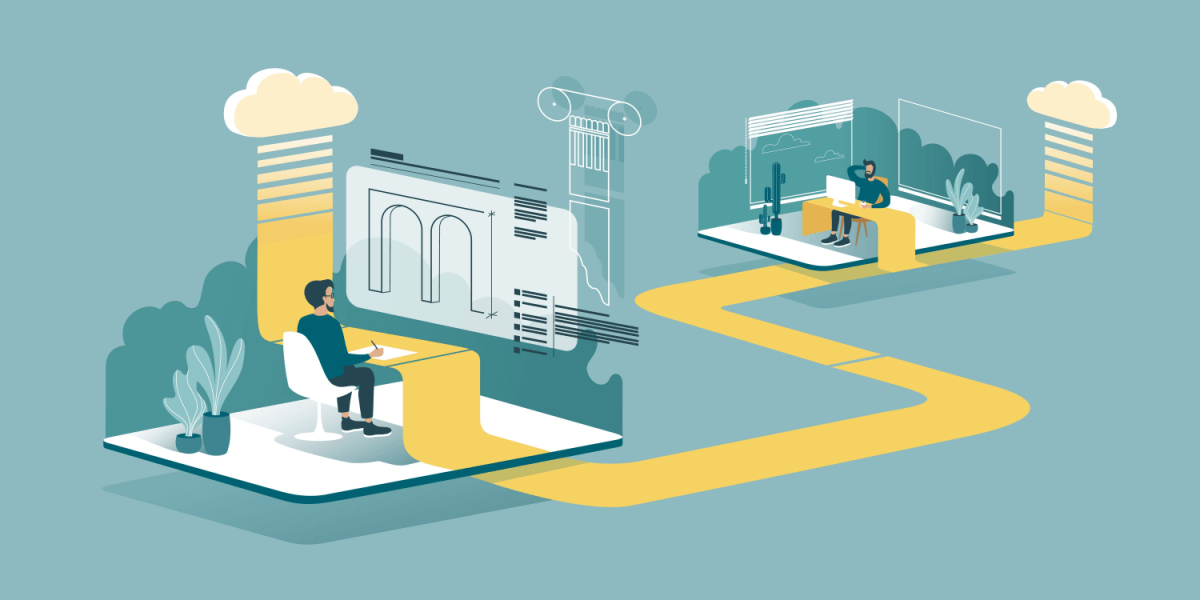Table of Contents
Documents, spreadsheets, and file folders are digital items that staff members or managers regularly access on a workday. If your employees work remotely, they need access to digital items and information technology (IT) resources without having to transfer or print physical copies.
Desktop support software enables this online data exchange and helps computer technicians diagnose and troubleshoot devices remotely.
This article discusses remote desktop support software, how it works, and the benefits it offers companies. It also highlights how IT support outsourcing ensures smooth remote operations.
What Is Remote Desktop Support?

Remote desktop support is assistance rendered to a certain computer from another device via the internet or networking. Technicians can access employees’ computers remotely and view and modify their network resources, apps, and files.
Remote desktop support is an essential component of back-office outsourcing services. Technical personnel handles the following:
- Troubleshooting errors
- Operating system support
- Upgrades and patch support
- Application installation and support
- Antivirus support
Remote support specialists handle tickets that cannot be solved over the phone or through chat. They diagnose problems on a desktop, figure out the cause, and apply appropriate solutions from a distant location without the user having to do anything. Effective and efficient desktop support requires a strong network and reliable tools.
Desktop support also keeps end users from troubleshooting devices they do not know much about. It reduces IT downtime and makes it cheaper and easier to fix desktop-related problems. Instead of going to the site, technicians use software to provide virtual help through the computer.
What Is Remote Desktop Support Software?
Remote desktop support software is a platform that lets two devices (e.g., computers, tablets, etc.) connect wirelessly through an internal network or the internet. Once connected, the user of a second device can take control of the first device and access its files as if it were working locally on the first device. Note that these two devices can be on opposite ends of the world.
For example, the first device is in the U.S., while the other is in Asia. The Asia-based desktop support team of a U.S. startup runs remote desktop support software on their computer to access files and applications or even fix the startup’s computers.
Desktop support software solves problems regarding:
- Remote access. Desktop support software lets technicians work from anywhere with complete access to any device. Technicians can remain productive regardless of location with access to your organization’s applications, files, mobile devices, and the required services. Plus, they need not use a virtual private network (VPN).
- Remote support. Desktop support software enables instant support for employees and customers. Forget expensive on-site visits. The IT team can solve any technical problem remotely with a secure and powerful solution. Desktop support software is compatible with most devices and servers.
- Remote work. Desktop support software has a wide device coverage. Technicians can access the software on any mobile device. The platform lets remote employees work on the go by covering every Android device and providing iOS screen sharing.
How Does Remote Desktop Support Software Work?

Remote desktop support software connects a remote device to a host computer using the internet or an internal network. You need to download and install the software on both devices to establish the connection and allow them to communicate. With the connection in place, the software lets technicians control the host desktop while using a remote computer.
A remote desktop software connection relies on several protocols, including:
- A remote frame buffer (RFB). This protocol grants remote access to graphical user interfaces. It functions on the frame-buffer level, which communicates with the rendered screen image. This means that it can be applied to all windowing systems.
- Remote desktop protocol (RDP). Remote desktop software utilizes RDP to establish the initial connection and send data between two devices. RDP runs applications using a secure network and encrypts the data.
- Independent computing architecture (ICA). This proprietary protocol lets an application’s user interface (UI) run with minimal resource consumption on the client device. The actual application logic executes on an ICA-enabled server. ICA is an alternative to RDP.
Remote desktop software captures a computer’s screen and keyboard or mouse inputs. It sends such inputs to the technician’s device so that they can see or control it from afar. Technical support agents use remote desktop connectivity to troubleshoot issues on a customer’s device.
Most tools allow host and remote devices to share files and clipboard content. It also allows access to audio, where the sound from the host device transfers to the remote computer.
Back-office outsourcing providers use remote desktop connectivity to perform tasks such as:
- Accessing a corporate computer from home or during a vacation
- Fixing a device problem
- Accessing a personal device from other locations
- Performing administrative tasks
- Performing file transfers from one desktop to another
- Demonstrating a software application or process
- Printing documents from the secondary machine
Essential Remote Desktop Support Software Features
About 16% of companies worldwide are remote, and 62% have implemented a hybrid model. This means that technical support teams must be able to work from different places. As such, remote desktop support software is helpful.
Not all desktop support applications are created equally. A reliable desktop solution should have the features discussed below.
Remote Device Control
This feature lets you directly access and control a remote computer or Android device as if it were right in front of you. This way, you can implement solutions as though you were the primary user on the device and fix issues seamlessly.
You need not worry about traveling to customers, coworkers, or servers to fix technical issues. Physically handling a device is no longer necessary because you can access it remotely. That also means you can solve problems and perform IT tasks from anywhere.
Worried about security? The best remote desktop software provides end-to-end encryption, blacklists, whitelists, and many more industry-leading security measures to ensure you and your customers are safe.
Remote Terminal
IT technicians can agree that tasks such as network troubleshooting and system diagnostics are easier to accomplish at the command line.
Remote desktop support software lets the IT team directly access remote terminals without using their device’s graphical user interface (GUI) or establishing a remote control session. Technicians provide efficient and discreet support by working behind the scenes, ensuring minimal disturbance to the end user.
VPN Alternative
Access enterprise-class scalability and security without the usual costs and complexities of acquiring a VPN.
Deploying a VPN is cumbersome and expensive for small businesses. But even enterprises with global offices have to pay a hefty sum to access documents from corporate desktops connected to the same VPN. Even if you have a VPN, it might run slowly, and lagging applications are one of the major productivity killers in business.
Desktop support infrastructure is an all-in-one solution for remote desktop access to Windows computers, remote file access, and remote server maintenance. Plus, you can get the whole software for a fraction of the cost of maintaining a VPN.
Cross-platform Access
Remote desktop support creates connections across multiple platforms, from PC to PC, PC to mobile, mobile to PC, and mobile to mobile.
Regardless of who the end user is, technicians can easily solve issues no matter what device or operating system they are on. The IT team accesses problematic devices from their PC, laptop, tablet, or smartphone.
Remote desktop support software allows agents and users to connect across platforms as long as their devices support macOS, Windows, Chrome OS, Android, or iOS. With the upcoming release of Apple’s macOS, it’s important to stay updated on what’s new in Sequoia to ensure compatibility and take advantage of the latest features.
Mobile Device Access
Access iOS and Android devices from your desktop computer with outsourced tech solutions. Seamlessly extend remote IT coverage and tech administrative services to mobile devices to make support more convenient for customers and colleagues.
Some solutions come with mobile apps that allow technicians to support any device from their phone. With it, the IT team can access corporate desktops, modify all files and apps, or easily transfer documents from one device to another. All of these are possible regardless of the technician’s location.
Secure Unattended Access
Do your support team members need access to an unattended device? Use remote desktop support software to gain permanent access without on-site visits.
With this feature, the IT team no longer needs to deploy agents to distant locations only to grant access to a device. They can safely take control of an unattended device with the right permissions and one simple click.
Desktop support software also reduces the risk of compromised connections. The IT team can assign rights to all computers from the start so that unauthorized individuals never get access to devices.
Comprehensive Reporting
Comprehensive reporting improves billing precision and productivity. This feature lets you record and trace incoming and outgoing connections to determine who has done what, when, and for how long.
Use this reporting feature to track incoming and outgoing connections, monitor employee performance, and design an accurate billing structure. With a comprehensive record of your accounts’ activity, you can easily manage your organization.
Desktop support software also provides in-session commenting and client feedback forms, which help you understand customer needs better.
Multi-user Support Session
Remote desktop support software with this feature lets you invite multiple IT technicians into complex support scenarios. It gives your team the ability to solve any issue within their means.
Suppose a technician is knee-deep in an IT problem on a remote device, and they cannot find a solution. With a multi-user support session, they can invite another technician to access the same remote device and help resolve the problem.
With this feature, technicians can assist colleagues who do not have admin permissions. It also allows the IT team to support users remotely and securely with a straightforward solution. IT agents can invite another user in with a single click, even during a remote session.
End-to-end Security
One of the main concerns for remote connectivity is security. A robust solution infused state-of-the-art security into your product.
Look for end-to-end security features, data centers certified by the International Organization for Standardizations (ISO) and with System and Organization Controls 2 (SOC 2), and Advanced Encryption Standard (AES) 256-bit session encryption to ensure your computers and data are secure. Consider features such as intense monitoring, unusual activity detection, two-factor authentication, and reporting for a secondary layer of protection.
Chat Options
Good communication is key to successful technical support. When collaborating on a task or project, maintaining open communication helps your IT team finish the job quickly.
A messaging feature lets you collaborate with your teammates via chat, video, and screen sharing. Whether IT agents need to update a customer or message a coworker, the right chat option should be accessible.
Different Use Cases of Remote Desktop Support Software

Businesses across different industries use desktop support software to deliver a smoother experience for users and employees.
For companies providing digital services to their clients, remote desktop support allows agents to connect to a customer’s desktop from another location. The agent can then identify the issue and address it immediately without an in-person meeting.
Furthermore, remote desktop software connects work-from-home (WFH) employees to their workstations at the office. This way, they can access files and other data needed for work without traveling to the company premises.
Here are the top use cases for remote desktop software:
- Demonstrate something to a customer, such as a software application or a process
- Fix a computer problem or bug
- Perform admin tasks
- Extend computing resources for applications without increasing employees’ endpoints.
- Install new applications on a centralized server and provide endpoints for remote access.
- Connect to legacy systems
- Promote collaboration among dispersed employees
- Access an office computer from home or when traveling
- Control a home computer from other locations
- Transfer files from one device to another
- Facilitate peer-to-peer file sharing via screen share
- Print documents and files from a remote computer
Who Uses Remote Desktop Support Software?
IT technicians, customer success teams, technical support agents, and IT staff members are the primary users of remote desktop support software.
- IT technicians and support agents use remote access to configure data centers and other industrial applications.
- Customer success teams use this software to find real-time solutions without having to meet in person.
- IT team managers create reports, help with IT problems, set up a workflow, and offer additional staff support.
Remote access has become essential in the last two years. Whether you choose a default OS method or specific enterprise software, desktop support software enables IT experts to improve employee flexibility and increase workforce productivity.
Benefits of Remote Desktop Support Software
Remote desktop support software can be extremely beneficial whether you want to assist your remote employees or help IT technicians streamline processes. Here are a few advantages of using the software:
Easier and Smoother Scaling
Remote desktop solutions have multiple plans and pricing options. You can determine the most suitable plan for your business by assessing several factors. For instance, the pricing varies depending on how many seats or devices you need to connect.
Some programs have a plan for 15 users who can access corporate computers. Others allow up to 100 employees to connect.
Guaranteed Simple Setup
Unlike other technical solutions, remote desktop programs do not involve complicated installation and setup processes. Most of the time, you can install the software without the intervention of a specialist.
Some solutions need to be installed on both the host and remote devices. Others need to be installed only on the host computer. In the latter case, the software gives you an access code or web link to connect the second desktop to the host. Either way, the setup is easy and takes only a few minutes.
Ease of Device Management
Troubleshooting IT problems is part of what technicians do daily. But they also need to ensure that each device complies with corporate policies and has updated software installed.
Remote desktop support software helps IT technicians accomplish all these tasks from afar. With remote access, technicians can fully support the organization without on-site visits.
Easier Collaboration
Although employees work from different locations, they still need to work together. A remote desktop solution allows employees to share files and collaborate effectively using a mirrored or shared screen.
For instance, a technician can demonstrate how to configure the settings within a work application. They can control their coworker’s desktops and perform actions without installing the application on their computer.
Synchronized Teams
Your teams stay in sync when user data and context, tracking and analytics tools, and automation-friendly workflow are all in one place. Remote desktop support software lets your IT team address problems in a single platform, reducing the need to switch between multiple apps and tools. It lets them understand the user journey better and concentrate on improving the experience.
Employee Success
Using the best tools leads to more productive employees. Unified desktop support software makes technicians’ work easier. They can be consistent and deliver a better user experience. Consequently, staff members can concentrate on more important matters instead of fixing their computers when they have an effective technical support team.
Better Remote Accessibility
Gallup found that, in September 2021, 45% of employees worked remotely on certain days of the week. Working from home has become more prevalent in the past few years. Businesses had to run their usual processes while keeping staff safe during the pandemic, so virtual arrangements were the only way forward.
Remote desktop software helped immensely with this transition. Without virtual support, employees would have had to go to the office regularly to access files, print documents, and accomplish other tasks on their company computers.
But remote desktop support software helped workers fulfill their responsibilities at home or anywhere in the world.
Challenges of Using Remote Desktop Support Software

You can use ways to deploy remote desktop support software. Some vendors offer free tools; others are more enterprise-ready. It can pose challenges for IT teams if users install remote desktop support without prior notification or approval.
Other challenges can also include:
- Limited bandwidth. Using remote desktops requires bandwidth. You might witness some performance and response time issues such as lagging mouse movements.
- Lower quality. Playing videos on a remote device is not suitable. RDP needs to transition the screens and frames, thus affecting video quality.
- The difference in capabilities. Not all remote desktop support software has the same features and capabilities, making it harder for companies and users to identify the best tools for their needs.
- Incapable of integration. Some tools might not integrate with your current systems. What good is desktop support software if it clashes with your current workflow and messaging channels? Look for a platform that can adapt and integrate easily.
- Bad time to value. The best desktop software should not be complicated. Choose one with a simple and intuitive setup, customization, and administration, so you waste less time and resources on the app and more on high-value activities.
- Unscalable software. Users want to feel supported. If your application capacity does not expand along with the number of users, they will not stay for long. Look for a solution that can scale up or down depending on the demands and needs of your users.
- Vulnerable to threat actors. RDP is a prime target for hackers and cybercriminals because it is widely used due to its convenience.
You can avoid the challenges mentioned above by choosing a reputable service provider or following best practices when deploying remote desktop support. Ask what an outsourced IT provider can do to ensure improved connectivity, better security, and a more robust feature set.
For instance, one of the most straightforward ways to reduce cybersecurity risk is by blocking all RDP connections outside the corporate network. If you absolutely need to allow other RDP connections, consider these measures to improve security:
- Try authentication methods. Use strong passwords. Expert hackers can still break complex passwords, but having a strong one can ward off hackers looking for an easy and quick target. Adding multifactor authentication is also a great option.
- Task network admin with monitoring failed attempts. Too many failed log-ins from a single IP address or user ID might signal a brute-force attack. Tracking or flagging failed attempts that pass a certain threshold is best practice.
Examples of Remote Desktop Support Software
Given the many outsourced IT solutions on the market nowadays, companies have plenty of options when it comes to remote desktop software. Below are some of the programs commonly used by desktop support teams when providing remote services.
- TeamViewer: Over 2.5 billion devices use TeamViewer. It lets users maintain access to a desktop while working from a remote computer, tablet, mobile phone, or another server without requiring a VPN. It works on Windows, Mac, and Linux and supports file sharing, private remote access, videoconferencing, and remote printing.
- AnyDesk: This tool allows quick and seamless file transfers. It comes with features such as cloud-based access and unattended access and is easy to use, thanks to its condensed, hidden menus and tabbed browsing experience. AnyDesk is compatible with Windows, Mac, and Linux and supports session recording and conferencing.
- ConnectWise: Unattended access works seamlessly, so users can access computers fast. Users must create an access agent installer to connect to the host device. This allows them to share files and folders with anyone and keep the desktop organized with a drag-and-drop interface. It works well with Windows, Mac, and Linux.
When Should You Outsource Desktop Support?
Consider outsourcing if cybersecurity is not your forte or you spend too many resources on desktop support. Outsourcing is also a good option when you want to expand or tap into the international market. Otherwise, you can start outsourcing when outdated technology holds you back or you cannot recruit and retain talented staff.
Outsourced IT trends show that BPO will continue to expand. Companies with multiple locations benefit from outsourcing because technicians can remotely support users across multiple branches.
Many businesses find outsourcing the most cost-efficient and effective way to manage desktop support. Ultimately, your decision should depend on your specific needs.
This section explores six signs indicating that it might be time for your business to outsource desktop support. If any of the following signs pertain to your company, consider restructuring your organization’s IT system.
Spending Too Much Time and Money on IT
The combined cost of IT investments and operational management can easily skyrocket and be impossible to control. As a result, businesses waste too much time maintaining a costly system or somehow end up with multiple systems that do not integrate.
Organizations then assign desktop support duties to in-house employees, who end up focusing on coordinating IT questions and issues, distracting them from their core responsibilities.
Outsourcing desktop support eases the burden on your in-house team by shifting the responsibility to dedicated technicians. Working with a qualified service provider that uses the latest remote desktop support software helps you control costs and improve business operations.
By outsourcing, you can eliminate the need for an in-house IT team and reduce labor costs. You can take advantage of lower rates and still receive the same quality of work that you get from hiring in-house. Lastly, you can leverage the expertise and experience of the BPO company.
Unable to Manage Cybersecurity Properly
Cybersecurity is a critical concern for all companies. Without proper protection, organizations can be victims of data breaches and cybercrime, leading to reputational damage, financial losses, theft of private information, costly blunders, and lawsuits. Businesses that cannot manage cybersecurity well are at a higher risk of attack.
Poorly managed cybersecurity is one of the drivers of data breaches because it lacks the necessary safeguards, coordinated strategies, and standards.
Outsourcing desktop support protects your security by tapping into experts knowledgeable in handling cyber policies and tools. A BPO company helps you address IT security across processes, people, and technology for efficient cyber protection.
Growing or Changing Business
As your company expands, so does the complexity and need for remote desktop support software. Since the widespread adoption of remote work, desktop support has spread far beyond the confines of the office. It now supports more devices, compliance challenges, and cybersecurity risks.
Outsourcing frees up your internal resources, letting you concentrate on other business areas. Moreover, companies can get better access to innovative technologies by working with a BPO vendor. The service provider develops IT strategies that support your organizational goals and give you a competitive advantage.
In the modern world, technology is business, and business is technology. Do not let your current systems hold you back. Propel your growth by working with a reputable BPO company.
IT Is Holding You Back
Not investing in technology is failing to invest in your business. Technology underpins every aspect of operations. Since more companies are moving online and adopting remote work arrangements, providing subpar IT support only gives your competitors the advantage.
Businesses need the latest skills and technologies, such as remote desktop support software, to innovate and grow. Without innovation, a business will stagnate. Giving employees the right tools and equipment to make them more efficient is not an expense but an investment.
Giving staff a better remote working experience and access to technology keeps them more productive and engaged. It also reduces instances of employees spending too much time looking for a file or trying to connect to corporate networks.
BPO companies are also ahead of the curve in terms of implementing new technologies. Maximizing their next-generation capabilities can significantly impact your business growth.
Unable To Recruit and Retain Desktop Technicians
Talented desktop technicians are difficult to find and retain. Businesses need a technician who can contribute on a strategic level. This individual is unlikely to be interested in solving daily computer issues. If your expert technician is often tasked with basic IT concerns, then you must not be getting the most out of your labor costs.
In addition, technicians have to be passionate about their work. A saying goes, “You do not hire an IT person; you hire an IT department.”
Moreover, in-house employees tend to feel limited by inadequate in-house resources, resulting in little value for the business. When presented with more opportunities and options to further develop their skills, technicians might leave, exposing a knowledge gap and significant shortcomings in your business.
A better strategy is to hire a BPO provider with the right remote desktop support software, skills, certification, and accreditation.
IT Projects Are Pending
Poor organization and inefficiency lead to missed deadlines and a backlog of incomplete IT projects. IT projects further suffer from poor communication, a lack of understanding between the parties involved, budget overruns, and unrealistic deadlines.
In-house teams sometimes fail to grasp the demands of certain projects, making it more challenging to plan and allocate the necessary resources.
Alternatively, BPO partners have enough resources to effectively and quickly accomplish projects based on your requirements. They must meet your deadlines instead of relying on an in-house team.
How To Choose the Right Software Provider?

The first step in choosing the right remote desktop support software provider is to evaluate and determine your non-negotiable requirements. Knowing your needs helps you narrow down your options. When researching providers, make sure to ask about their qualifications and check their track records.
Consider the tips below to learn more.
Assess Your Needs
Decide whether proximity matters to you. Do you need IT technicians to be physically present for meetings, or is video calling enough? If it is the latter, then you can continue searching for a BPO provider.
Distance is worth considering because third-party desktop support technicians can fix basic computer issues without needing to visit the office. They provide exceptional remote service when you need it, even on holidays.
Do Your Due Diligence
Now that you understand your needs start searching for service providers. Begin by visiting the websites of several desktop support companies. Check their portfolios, client details, and testimonials to learn more about each vendor.
After completing your research, short-list three to four firms based on their strengths and capabilities. If a particular provider does not meet your needs, move on to the next prospect.
Ask for Qualifications
Plan a meeting with each remote desktop support software provider and ask about their qualifications. Know that to get the best service, you need to find a firm consisting of talented contractors with advanced technical experience and qualifications.
Do not be afraid to ask about qualifications directly. If providers refuse to answer, that is a clear indicator that you should reconsider working with them.
Discuss Response Time
Desktop support providers work 24/7 to provide instant service. Ensure that everything will be smooth sailing in the future by asking the provider how quickly they can respond to work orders. For instance, a one-hour response time means the technician responds within an hour, including when you make the call.
Conduct a Background Check
Lastly, ask for references and follow up on those contacts before deciding. Check whether the service providers have state-of-the-art equipment and software to access your network remotely. Ask if they have worked with any major clients. If so, do not forget to contact the references to verify the vendor’s claims.
Signs That You Have Found the Right IT Support Vendor
Outsourced desktop support should improve efficiency, reduce operating expenses, tighten cybersecurity, and free up resources for new product or service development and growth. By partnering with a reliable provider, small and midsize businesses are free to expand.
Larger enterprises with more resources and oversight have a higher chance of successfully maintaining an in-house IT department. However, a trusted BPO firm gives access to specialists for operational efficiencies, strategic alignments, cybersecurity, and complex projects.
That said, businesses of all sizes can reap the benefits of outsourcing only when they partner with the right provider. Take note of the following signs to know if you have found the right remote desktop support software vendor:
- They have experienced employees with a wide variety of IT specialties.
- They have a fully staffed team. So even if contractors go on vacation simultaneously, you do not experience major delays.
- Their reference contacts verify their claims.
- They know how your business works and how your tools support operations.
- They understand how to leverage technology as a competitive advantage.
- They are interested in helping you find technologies that let you be more efficient.
- You receive a quick response to email inquiries.
- A live agent answers the phone when you call.
- Their pricing structure can easily be predicted for easy budgeting.
- They want to help you avoid downtime, losses, and exposure to cybercrime actors.
Have you noticed that we have not talked about pricing yet?
Whether you outsource data entry services or desktop support, price is an excellent indicator of whether a service provider is right for you. Low pricing does not always mean ineffectual contractors and expensive services do not ensure you will receive quality either.
What you need to look for is value. Here are questions to ask your potential provider:
- Do they have a reliable track record of solving IT problems quickly?
- Are they proactive in security protocols and maintenance?
- Can they partner with you for the long term and ensure scalability?
If the answer to all three questions is a resounding yes, that is the BPO partner you can trust with the assets that underpin all your operations.
The Bottom Line
Maintaining corporate computers, networks, and servers at peak performance levels is difficult for in-house technicians of sizable companies. Some midsize to large enterprises might not even have an in-house team in the first place.
Outsourcing to a provider with remote desktop support software is ideal for businesses that want uninterrupted and efficient operations. With this strategy, you get support whenever you need it. You no longer have to wait for a visit from specialists or bring devices to the office for fixing.
BPO companies invest not only in the best specialists but also in the best tools. They leverage relevant IT experience with an aptitude for technology. This way, you can ensure you get the best desktop support.
Are you ready to start your outsourcing journey? Contact Unity Communications today.




